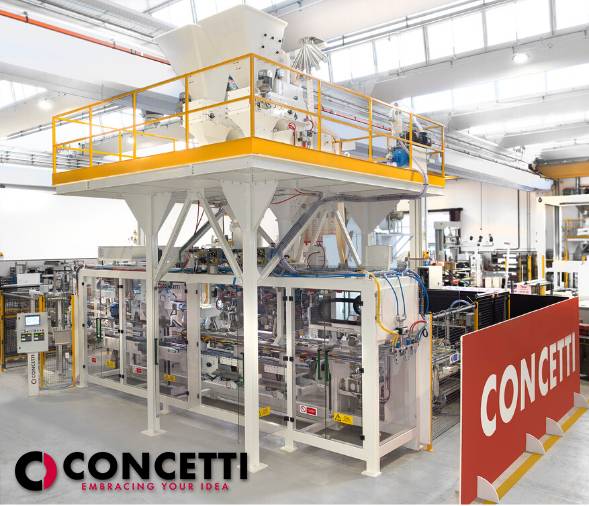
Keys to Successfully Implementing an Automated Packaging Line
Product packaging is integral to successful distribution, marketing and sales of any dry bulk product.
它提供基本的生活必需品像保护product from contamination during transportation, warehousing, retail and for the customer
It communicates to the end user your brand, features and benefits, specifications, safety information, product composition, etc.
It differentiates you from the competition and plays an integral role in the final stage of the decision making process!
In short, packaging your dry bulk goods is integral to the success of your company!
The good news is modern open-mouth bagging lines from companies like Concetti fully automate the process to provide excellent ROI. The following pages detail Bratney Companies experience selecting, installing and servicing Concetti open-mouth packaging lines for a variety of industries. Whether you sell seeds, grains, animal pre-mix, pet food, fertilizer, flour or concrete, this guide will walk you through the steps to successfully implement a bagging line in your facility. As always, Bratney process experts are ready to discuss your application and provide a solution.
Step 1: Your Product
It all starts with your product. Is it a powder, is it a pellet, is it free flowing, abrasive, corrosive? Do you know the bulk-density? Does it need to be de-aereated?
Don’t know? Don’t worry! Send us a sample and we will test it in our lab to answer all of these questions for you. This information will help narrow down the required bagging scale, whether it is gravity fed or force fed with a screw or conveyor and any special materials required for food safety or abrasion resistance.
Step 2: Your Bags – What Type and Size, and What Material
Open mouth baggers can accommodate a variety of bag types and should be able to change the entire line for a different bag in a few minutes or less. Understanding your bag type and size, and bag material up front will help us configure your bagger with the proper bag hanger, closing device, printing or labelers and most importantly have it factory programmed to run each different setup at the push of a button.
Bag Type
Some examples of the many bag types include: flat (pillow), gusseted, cross-bottom, block-bottom and pinch bottom open mouth (PBOM). Other special considerations are do they have handles or a zipper and would you like the bagging system to provide those features?
Bag Material
Examples of bag material includes: paper, paper with polyethylene (PE) liner, aluminated, PE from a reel (used in form, fill and seal systems), woven polypropylene, laminated woven polypropylene.
Why are all these details important? It allows us to automate systems for the hardest to handle bags giving you advantages in quality and production output over your competition. Check out this video of an automated system designed for aerated dairy powders!
Step 3: Production Goals
How many bags per hour do you need to achieve? 300 bags, 600 bags, 1,000 bags or more? Fully automatic bagging systems can be tailored to meet your production rate goals giving you flexibility to meet a tight budget or planning for production rates based on your long term sales forecasts.
Remember, an accurate quote from your open mouth packaging supplier must include individual production speeds for each bag size and weighment in your range. If it doesn’t you may end up disappointed with the actual speeds you’ll achieve on the outside ends of your range.
Step 4: Facility Requirements
Your plant space is finite and valuable which means you need to maximize your bagging line capabilities in the smallest footprint. Advancements in form, fill and seal technology have greatly increased production capabilities in small areas making the Concetti FFS machines particularly well suited for retrofitting existing plants.
One important consideration for retrofitting an open mouth bagger in your facility is planning for and minimizing potential downtime. If the new system is replacing an old system, is it going in the same spot? Can the old system continue to operate while the new system is being installed? What steps can we take together to minimize the impact on your current production?
Bratney’s Design, Construction and Installation team (DCI) can provide turn key facilities, retrofit existing facilities or simply provide drawings of the proposed bagging line in your facility to give contractors layout dimensions, floor loads, electrical ratings and air requirements. The DCI process experts have decades of combined experience designing optimal plant flows around customer objectives like maximum throughput, minimum footprint, minimal product handling and project budget.
Step 5: Budget
步骤1 - 4指导我们在你可能的解决方案r open mouth packaging line. Project budget narrows in our focus to select the right combination of production rates, automation and costs and it ultimately allows us to provide you with an accurate quote for a new bagging line. Use our territory managers as a resource to understand the balance of budget and ROI as often the least expensive solution does not provide the fastest or largest ROI.
Step 6: After Sale Service
Choosing the right partner to provide your open mouth bagging line or any capital equipment for that matter requires careful consideration of their service capacity. Selling machines designed to provide decades of service requires a customer service department ready to provide ongoing training, machine programming, technical support and parts in an immediate fashion. Does your partner have good references? Do they have a fully staffed service department? Do they have inventory on hand in the event something breaks to get you up and running next day? Ask these questions to make sure you choose a partner that can provide a full solution to both your pre and post sale needs.
Bratney Companies is the exclusive supplier forConcettiin North American agricultural markets. Concetti is a manufacturer ofturn-key automated packaging lines for bulk materials.




